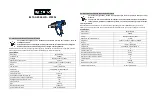
4 •
ELEMENT SPLIT - User Manual
ELEMENT SPLIT - User Manual
• 5
EN
FR
PL
CZ
12.
Never recharge a fully charged
battery. Overcharging shortens the
battery service life.
13.
Under abusive conditions, liquid
may be ejected from the battery; avoid
contact. If contact accidentally occurs,
flush with water. If liquid contacts eyes,
additionally seek medical help. Liquid
ejected from the battery may cause
irritation or burns.
14.
Suitable charging environment:
a. Charging temperature:
0°C ~40°C (32°F~104°F)
b. Discharging temperature:
0°C ~40°C (32°F~104°F)
c. Storage temperature:
-20°C ~60°C (-4°F~140°F)
Please wait one-hour first before
charging, if the battery pack is stored
under 0°C (32°F).
15.
Storage instructions of battery:
When battery pack is not in use, keep
it away from other metal objects like
paper clips, coins, wrenchs, nails,
screws, or other small metal objects
that can make a connection from
one terminal to another. Shorting the
battery terminals together may cause
burns or a fire.
a. If battery pack is at a low
temperature (under -20°C / -4°F) its
chemical elements will be in solid state
and resistance in charging will become
too high for the battery to be charged.
b. If battery pack is at a high
temperature (above 60°C / 140°F),
its chemical elements will be in a
vapor state that can make the battery
ineffective in a short time.
16.
The lithium battery safe protection
function:
a. The «low-voltage protect function»
will start when the lithium battery is
used for the first time. Please charge
the lithium battery to prevent battery
from damage.
b. After continous use, the temperature
of the lithium battery will keep rising.
When the temperature of the lithium
battery exceeds the max temperature,
battery the “temperature protection
function “will start.
The lithium battery will be locked to
prevent dangerous overheating please
wait till the lithium battery cools down.
c. The overload on the battery can
cause a voltage peak on the tool.. The
lithium battery pack will start “electric
current overload protection function”
to protect the lithium battery and
battery P.C. board. In this situation,
the tool will stop for a few seconds
until the protection function relieves
automatically. If the tool can not be
used after few minutes, the lithium
battery might be in “low-voltage
protecting function” or “temperature
protecting function”. Please follow
above mentioned ways to relieve.
17. A small leakage of liquid from
the battery pack may occur under
extreme usage or temperature. This
does not necessarily indicate a
failure of the battery pack. However,
if the outer seal is broken and
this leakage comes into contact
with your skin: Wash the affected
area quickly with soap and water.
Neutralize the liquid with a mild acid
such as lemon juice or vinegar. If the
leakage gets in your eyes. Flush your
eyes with clean water for a minimum
of 10 minutes and seek immediate
medical attention. Inform the medical
staff that the liquid is a 25-35% solution
of potassium hydroxide.
18. Do not store or carry a spare
battery pack in a pocket or toolbox or
any other place where it may come into
contact with metal objects. The battery
pack may be short circuited causing
damage to the battery pack, burns or
a fire. If storing or disposing the battery
pack, cover the terminals with a heavy
insulation tape to ensure short circuit
cannot occur. Batteries, when stored
for a long period of time, will discharge.
19. DANGER: If the battery pack is
cracked or damaged in any other way,
do not insert it in the charging base.
There is a danger of electric shock or
electrocution.
20. WARNING: Do not allow any liquid
to come into contact with the charger.
There is a danger of electric shock.
21. Do not place any object on the
top of the charger as it could cause
overheating. Do not place the charger
near any heat source.
22. Do not disassemble the charger.
Take it to an authorized service center
when service or repair is required.
Incorrect re-assembly may result
in the risk of fire, electric shock or
electrocution.
23. This appliance is not intended for
use by persons (including children)
with reduced physical, sensory
or mental capabilities, or lack of
experience and knowledge, unless
they have been given supervision
or instruction concerning use of the
appliance by a person responsible for
their safety.
24. lf the supply cord is damaged, it
must be replaced by the manufacturer,
its service agent or similarly qualified
persons in order to avoid a hazard.





































